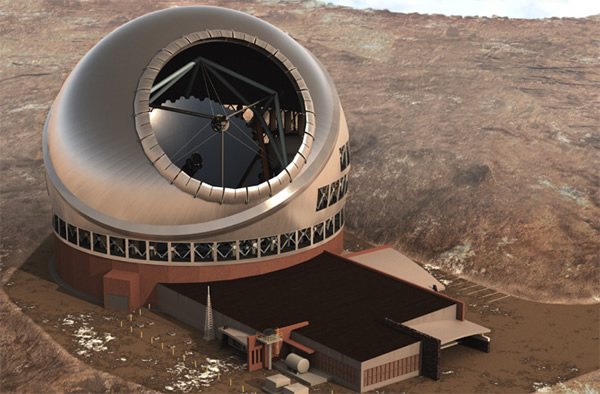Monster Hawaiian Telescope Approved
The summit of Mauna Kea on Big Island, Hawaii, already plays host to 13 observatories and now a new, monster addition the telescopic family is one step closer to reality.
The Thirty Meter Telescope (TMT) will dwarf all of its Mauna Kea siblings. The dome, pictured above, will house a huge 30-meter, 492-segment mirror capable of capturing observations 12-times sharper than the Hubble Space Telescope. The project is a collaboration between Caltech, the University of California and the Association of Canadian Universities for Research in Astronomy (ACURA).
Instruments attached to this huge collecting area will be able to pick out some of the faintest objects in the ancient (and distant) universe. The TMT will be the most powerful telescope on the planet, observing wavelengths from near-infrared, through optical to ultraviolet. The next-largest telescopes on the 4,200 meter-high mountain, the twin 10-meter Keck telescopes of the W. M. Keck Observatory, will be dwarfed by the TMT.
Monster Hawaiian Telescope Approved
But like all large observatories, they take up a lot of space, often on protected land with delicate environments. In the case of the TMT, special considerations for local culture and environmental impacts needed to weighed up after legal challenges against the TMT’s construction were submitted. But, after two years of discussions, the Hawaiian Board of Land and Natural Resources (BLNR) have issued a permit allowing work to begin on construction of the observatory in April 2014. It is hoped first science observations will begin around 2021.
“We are delighted that the TMT project has now been granted a Conservation District Use Permit,” said Ed Stone, physics professor at Caltech and vice chair of the TMT board. “The BLNR’s decision is a vote of confidence for TMT advancing science while benefiting the greater Hawaiian community.”
Use of the land atop Mauna Kea has been contested over the years. The land is considered sacred to the Hawaiian people and due to its very sensitive environment, construction projects undergo intense scrutiny before they can become a reality.
But in this case, the science argument, while minimizing environmental impact, won over the authorities. For more on the cultural and legal implications of the TMT’s construction, read the fascinating analysis by Andrew Cooper, W. M. Keck Observatory engineer and photographer.(Apr 18, 2013 03:09 PM ET // by Ian O'Neill )












